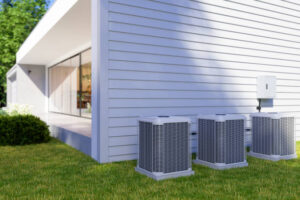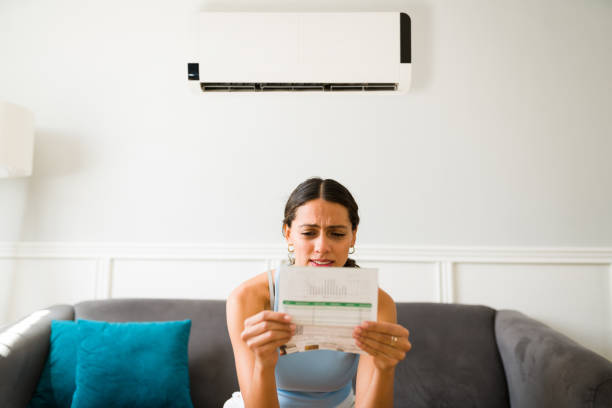Are you tired of seeing your hard-earned money disappear into thin air, all thanks to those sky-high home heating and cooling bills? You’re not alone! With the seasons changing and temperatures either climbing to new heights or dropping to chilly lows, finding the most effective ways to cut down on those energy bills is more important than ever.
But where do you start? This article dives deep into the heart of your home’s energy consumption, offering practical and innovative strategies to not only understand where your energy is going but also how to make impactful changes. From sealing those sneaky drafts to investing in energy-efficient appliances and exploring the benefits of renewable energy sources, we’ve got you covered.
So, grab a cup of coffee and get ready to transform your home into a model of efficiency and savings. Let’s embark on this journey together towards a more sustainable and wallet-friendly home environment!
Understand Your Current Energy Usage

Understanding your current energy usage is the foundational step toward achieving a more sustainable and cost-effective energy management strategy. This process involves closely monitoring and analyzing the amount of energy consumed by your household or organization, identifying the primary sources of energy use, and recognizing patterns or trends in your energy consumption over time. By gaining a comprehensive understanding of where and how energy is used, individuals and businesses can make informed decisions about where to implement energy-saving measures, potentially leading to significant reductions in both carbon footprint and energy costs.
The goal of understanding your current energy usage is not just about cutting costs, but also about contributing to a larger effort of reducing environmental impact. It involves a detailed assessment of all energy inputs and outputs, including electricity, gas, and other fuels. This might include examining utility bills over a period of time, utilizing smart meters that provide real-time data on energy consumption, or conducting energy audits to pinpoint inefficiencies.
Armed with this knowledge, one can prioritize actions, such as upgrading to energy-efficient appliances, improving insulation, or switching to renewable energy sources, to enhance energy efficiency. Additionally, understanding energy usage patterns can help in setting realistic energy-saving goals and tracking progress over time. In essence, comprehending your current energy usage serves as the critical first step in the journey towards a more energy-efficient and environmentally friendly future.
It empowers homeowners and businesses alike with the knowledge needed to make impactful changes, ensuring that every effort made towards energy conservation is as effective as possible.
Related Reading: What Is Ideal Static Pressure In HVAC? Find Out Now
Identify Areas of Energy Waste
Identifying areas of energy waste is crucial for optimizing your home’s energy efficiency and reducing unnecessary expenses. Look for common culprits such as drafty windows or doors that allow heat to escape, leading to higher heating bills. Poor insulation in walls and attic spaces can also contribute significantly to energy loss, making your heating or cooling systems work harder than they need to.
Additionally, outdated or inefficient heating and cooling systems can consume more energy than modern, energy-efficient models, resulting in inflated energy bills. By pinpointing these areas of inefficiency, homeowners can take targeted actions to improve their home’s energy performance. This could include sealing leaks around windows and doors, upgrading insulation, or replacing old appliances with ENERGY STAR rated models.
Not only does addressing these issues lower energy bills, but it also enhances the comfort of your living environment and reduces your carbon footprint.
Drafty Windows or Doors Leading to Heat Loss
Drafty windows and doors are a major source of energy waste in homes. They allow warm air to escape during the winter and cool air to slip out in the summer, forcing heating and cooling systems to work overtime. Sealing these leaks can significantly reduce energy bills and improve the overall comfort of your home.
Poor Insulation in Walls and Attic Spaces
Inadequate insulation in walls and attic spaces results in valuable heat escaping in the winter and unwanted heat penetrating during the summer. Upgrading insulation is an effective strategy to boost your home’s energy efficiency, keeping it warmer in the colder months and cooler in the warmer months, while simultaneously reducing energy consumption.
Inefficient Heating or Cooling Systems Consuming Excess Energy
Old or inefficient heating and cooling systems are notorious for consuming an excessive amount of energy. Replacing these systems with modern, energy-efficient models not only dramatically lowers energy bills but also reduces the environmental impact associated with heating and cooling your home.
Invest in Energy-Efficient Appliances

Investing in energy-efficient appliances is a pivotal step towards reducing your home’s energy consumption and lowering utility bills. Appliances with an ENERGY STAR rating are designed to use minimal electricity without sacrificing performance. For instance, programmable thermostats allow you to control your home’s temperature efficiently, ensuring that heating and cooling systems are used only when necessary.
This not only saves energy but also extends the lifespan of your appliances by reducing their operational hours. By choosing energy-efficient models for your home, you contribute to a greener planet while also enjoying the benefits of lower energy costs.
ENERGY STAR Rated Heating and Cooling Systems for Lower Bills
ENERGY STAR rated heating and cooling systems utilize advanced technology to achieve maximum energy efficiency, leading to significantly lower utility bills. These systems are specifically designed to use less electricity while still providing the comfort levels you desire in your home. Opting for ENERGY STAR appliances is a wise decision for anyone looking to cut energy costs and lessen their environmental footprint.
Programmable Thermostats to Control Temperature Efficiently
Programmable thermostats offer a smart solution for managing your home’s temperature in an efficient manner. By allowing you to set your thermostat to automatically adjust to different temperatures throughout the day, based on your schedule, you can ensure that energy is not being wasted on heating or cooling when no one is home. This technology not only provides comfort when you are home but also contributes to significant savings on energy bills and a reduction in your carbon footprint.
Improve Home Insulation
Improving home insulation is a key strategy for enhancing energy efficiency and comfort in your living spaces. Effective insulation acts as a barrier to heat flow, keeping your home warm in the winter and cool in the summer. Attic insulation is particularly crucial, as it can significantly reduce heat loss, leading to lower heating bills.
Similarly, sealing windows and doors to prevent air leaks can dramatically improve your home’s ability to maintain a consistent temperature. These upgrades not only make your home more comfortable but also reduce the strain on your heating and cooling systems, thereby lowering your energy consumption and costs.
Attic Insulation to Reduce Heat Loss in Winter
Attic insulation is crucial for minimizing heat loss during the chilly winter months. By enhancing the insulation in your attic, you significantly reduce the amount of heat that escapes, keeping your living areas warmer and reducing the need for excessive heating. This upgrade not only improves comfort but also results in noticeable energy bill savings.
Sealing Windows and Doors to Prevent Air Leaks
Sealing windows and doors effectively prevents unwanted air leaks. Gaps around these areas can let warm air escape in winter and cool air in summer, making your HVAC system work harder than necessary. Applying weatherstripping or caulk to seal these leaks boosts your home’s energy efficiency, lowers energy consumption, and elevates comfort levels.
Utilize Natural Heating and Cooling

Utilizing natural heating and cooling methods is an effective way to enhance your home’s energy efficiency while reducing reliance on mechanical systems. Opening windows during cooler hours can invite fresh air in and help cool your home naturally, reducing the need for air conditioning. Similarly, using thermal drapes can help retain heat in the winter and keep your home cool in the summer by blocking out sunlight.
These strategies not only help in maintaining a comfortable indoor temperature but also contribute to significant energy savings by minimizing the use of heating and cooling systems. Embracing these natural methods can lead to a more sustainable living environment and lower energy costs.
Open Windows for Natural Ventilation During Cooler Hours
Opening windows during the cooler parts of the day can significantly enhance natural ventilation. This not only reduces the reliance on air conditioning but also improves indoor air quality. By allowing the cool breeze to circulate, you can lower indoor temperatures naturally, leading to energy savings and a more comfortable home environment.
Use Thermal Drapes to Retain Heat in Winter and Cool in Summer
Thermal drapes serve as an effective barrier against external temperature changes. In the winter months, they help keep warmth inside, while in the summer, they block the sun’s heat from entering your home. Implementing thermal drapes is a smart strategy for naturally regulating your home’s temperature, which can help reduce your energy bills and ensure comfort throughout the year.
Regular Maintenance of Heating and Cooling Systems
Regular maintenance of heating and cooling systems is essential for ensuring their efficiency and longevity. Annual professional check-ups help in identifying and fixing any potential issues before they lead to major repairs. Regular filter changes are also crucial, as they maintain optimal air flow and air quality within your home.
This routine care not only keeps your systems running smoothly but also significantly reduces energy consumption, leading to lower utility bills. Moreover, well-maintained heating and cooling systems contribute to a more comfortable and healthier living environment by consistently regulating temperature and air quality.
Annual Professional Check-Ups to Ensure Efficiency
Annual professional check-ups are critical in ensuring that heating and cooling systems operate at their highest efficiency. These expert inspections can pinpoint and resolve any issues early on, averting expensive repairs and unnecessary energy use. An efficiently running system not only helps in reducing energy costs but also in prolonging the equipment’s life.
Regular Filter Changes to Maintain Air Flow and Quality
Regular filter changes play a key role in maintaining the optimal air flow and quality within your home. Clean filters prevent the accumulation of dust and debris, which can impede your heating and cooling systems’ performance. This straightforward maintenance task significantly influences energy efficiency and enhances the indoor air quality, promoting a healthier living environment.
Consider Renewable Energy Sources

Considering renewable energy sources is a forward-thinking approach to reducing dependency on traditional energy grids and minimizing environmental impact. Solar panels, for instance, harness the sun’s power to generate electricity, offering a sustainable and cost-effective alternative to conventional energy sources. Similarly, geothermal heating and cooling systems utilize the earth’s stable temperature to regulate indoor climate efficiently, further reducing energy consumption and costs.
By investing in renewable energy, homeowners and businesses not only contribute to a healthier planet but also enjoy long-term savings and energy independence. This shift towards renewable resources represents a critical step in achieving a more sustainable and eco-friendly future.
Solar Panels to Generate Electricity and Reduce Dependency on the Grid
Solar panels serve as an efficient way to generate electricity, significantly reducing dependency on the traditional power grid. By harnessing the sun’s energy, these panels convert sunlight into a clean, renewable source of power for both homes and businesses. This transition not only minimizes environmental impact but also offers substantial savings on electricity costs in the long run.
Geothermal Heating and Cooling Systems for Sustainable Temperature Control
Geothermal heating and cooling systems leverage the earth’s constant underground temperature to effectively manage indoor climate. This method of sustainable temperature control drastically cuts energy use compared to conventional HVAC systems. With geothermal technology, homeowners and businesses can enjoy a green, efficient solution for achieving year-round comfort, leading to significant energy conservation and reduced environmental footprint.
In Summary
Reducing your home heating and cooling bills is not only possible but practical with the right strategies. From upgrading to energy-efficient appliances and improving insulation, to regular maintenance and exploring renewable energy options, each step you take can lead to significant savings and a more comfortable home environment. Implementing these methods will not only lower your energy costs but also contribute positively to environmental conservation.
Ready to slash those high energy bills and enhance your home’s efficiency? Start with an energy audit today to identify key areas for improvement, and take the first step towards a greener, more cost-effective home. Contact our experts now and let us help you achieve optimal energy savings with tailored solutions!

